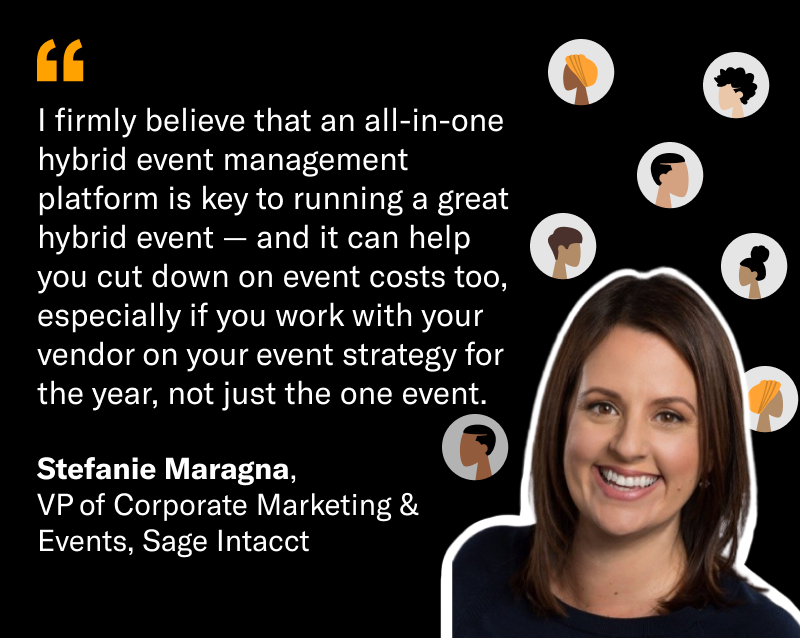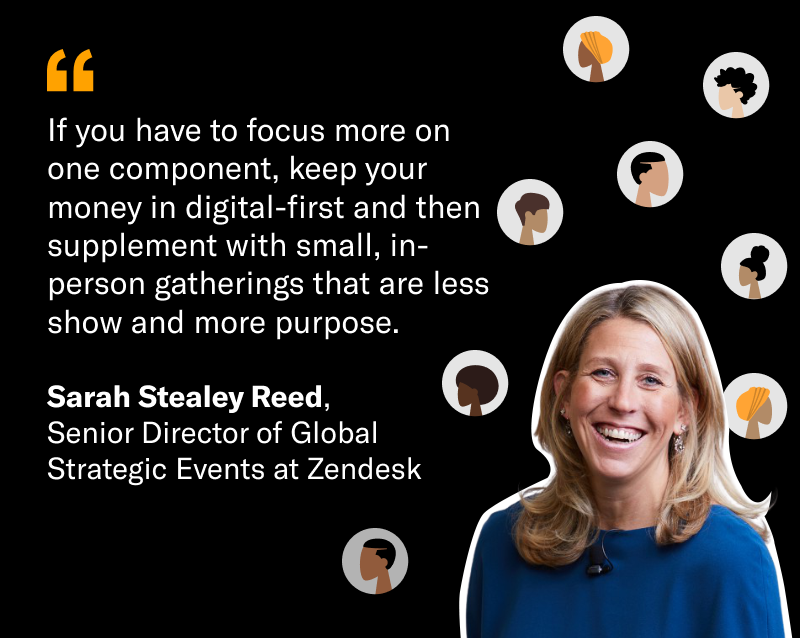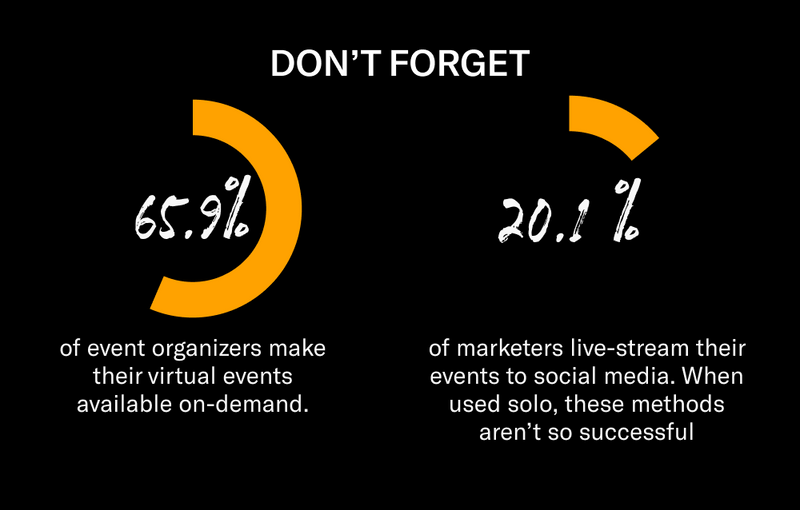Looking for Hybrid Event Ideas? Check out these 3 Hybrid Event Formats

Table of Contents
Maximize Your Marketing ROI
Join 10,000 other marketers already getting the best tips on running engaging events that boost pipeline and create raving fans.
Field marketers have spent the last two years on a steep learning curve with virtual events. Finding the right platform. Building new schedules. And producing Netflix-worthy digital content that will keep attendees coming back for more.
Honestly, the struggle has been real. But there have been some pretty huge results too. Especially for those who manage to utilize the right virtual event solutions and develop creative hybrid event ideas that aim to engage each person in a virtual audience.
Whether it’s doubling event attendance, generating 1K MQLs or positioning events as the second highest pipeline-creating channel — it’s no wonder virtual is set to retain a 40% share of events in 2022.
And although it may feel like we’re still finding our groove with virtual events, it’s time to check in on what’s next on the post-pandemic event era agenda. And with a predicted event share of 35% in 2022, it’s all about hybrid.
If you’re ready to take on the challenge of generating hybrid event ideas but aren’t sure where to start, we’re ready to show you exactly what that looks like and share some top tips to ensure success.
Here’s what we’ll cover:
- What is a hybrid event?
- What are the benefits of going hybrid?
- What are the different types of hybrid events? 3 hybrid formats to consider

First, what even is a hybrid event?
Truthfully, the hybrid event definition is still up for debate. But if you really want to boil it down and define a hybrid event, you can think of it hybrid as the pandemic-era lovechild of in-person and virtual events.
One part virtual and one part in-person, these events allow for bigger audience numbers, more engagement opportunities, and an all-round epic event experience.
For modern field marketers, realizing successful hybrid event ideas is a real ‘have your cake and eat it’ moment — if you approach them right.
When we sat down with event marketing extraordinaire Lisa Gregory for our own Goldcast event on Making Hybrid Happen, she explained the four ways she’s come to define hybrid events:
- Traditional: A beautiful main stage, live-streaming to an online audience, with special programming for the audience at home versus the in-person attendee.
- Virtual hybrid: Some parts pre-recorded and a live session every three tracks.
- In-person + virtual hybrid: A virtual conference on a platform like Goldcast, combined with streaming from an in-person venue, and speakers appearing at both.
- The hybrid sandwich: Take the content created at your in-person event and utilize it at your virtual event, alongside other engagement levers.
What are the benefits of going hybrid?
With 64% of companies already using a hybrid event model, there’s obviously something about them that works well for attendees.
Here are some of the major benefits of hybrid events, both for organizers and audiences:
- Access a global audience, without the need to travel.
- Going global increases attendee numbers.
- Broaden your attendee range and personas with different tracks for each.
- Cater to attendee preference with the option to attend in-person or virtually.
- With interactive platform functionalities, amplifying engagement is simple.
- Event platforms increase your access to more complete event data.
- Personalized follow-ups from your account-level data, generate higher ROI.
- Reduce your carbon footprint by minimizing the need for everyone to travel.
Ready to create a hybrid event both your team and attendees will love? Find out why hybrid events are a B2B marketer's best friend.

What are the different types of hybrid events? 3 hybrid formats to consider
Clearly, hybrid offers some super intriguing benefits for strategic event marketers.
But the first step to actually capturing those stellar results is to choose the right format for your hybrid event.
Here are three types of hybrid event formats to start with.
Hybrid event format #1: All-in and all-together
Hybrid event format star rating:
⭐⭐⭐⭐⭐
When it comes to the best hybrid event formats to follow, going all out on both the virtual and in-person components is a must. And if you can blend both audiences together for the perfect event mash-up, you’re onto a winner.
But don’t underestimate how tricky it is to pull that off.
If you want the rewards, you’ll have to put in the groundwork and get everyone attending to participate.
Tips for acing the all-in-one hybrid event format:
- All-in-one events need an all-in-one event platform — find the right platform that offers you everything you need to wow both your in-person and virtual attendees.
- Fail to plan, plan to fail — big rewards often come with some tricky logistics and that means you have to get savvy with role allocation and planning from day one.
- Remember, you’re producing one event but the virtual and in-person experience will (and should) be different — don’t try and box them together.
✅ Pros of an all-in-one hybrid event format:
- Putting 100% into both means achieving ultimate engagement for everyone.
- Double your 1:1 conversations, demos and sponsor talks with booths at both.
- Maximize event branding exposure across both your virtual platform and live venue.
- 2X the data insights to track hybrid event ROI and personalize follow-ups.
- 360° cross-channel interaction to expand global networking opportunities.
❌ Cons of an all-in-one hybrid event format:
- Tech, time, entertainment, and staffing costs can add up.
- With bespoke event tracks needed for both, logistics can get complex.
Hybrid event format #2: The sandwich model
Hybrid event format star rating:
⭐⭐⭐⭐
Running two events at the same time is a big ask, even for a seasoned event pro. If you take this approach, you’ll need to have multi-tasking, delegation and resource management down to a fine art.
So while the all-in-one hybrid event format may provide your attendees with the best all-round experience and generate the most complete data set, sometimes it just might not be possible.
That’s where Lisa’s sandwich model comes in a close second when it comes to choosing your hybrid event format.
“I love the sandwich model,” she says. “Have your in-person event first then, afterwards, host a virtual event using the in-person content and a unique virtual offering.”
Two uniquely engaging experiences. One rockstar content stream. Zero event juggling. 🤹
With the right platform, you can definitely make it happen. “With Goldcast, you can pre-record everything, edit the videos and use them at your virtual event within hours.”
Tips for acing the sandwich hybrid event format:
- It’s easy to over-index on in-person engagement and come up short when you get to virtual. Use a feature-fuelled virtual event platform to keep it equal.
- Content creation is key. Level-up your in-person content to make it easy to quickly repurpose it for the virtual event.
✅ Pros of the sandwich format:
- Less time spent on logistics, same interactive event engagement.
- It’s easier to keep both virtual and in-person event experiences equal when they’re not competing for your attention at the same time.
- If your events are separate, you can focus on different leads, KPIs, results and data for each.
❌ Cons of the sandwich model:
- Tech, time, and entertainment costs are still a factor.
- Separate events means separating attendees — your local, in-person audience will lose the global networking opportunities virtual provides.

Hybrid event format #3: All-in on in-person, but stream virtual
Hybrid event format star rating:
⭐⭐⭐
If you get to this stage, stop and review. Ask yourself, ‘Are my virtual attendees getting a spectacular experience here?’
Because chances are, if they’re viewing on-demand or sitting at home one-way streaming, the answer is no. And while it’s great that the option is there, experts like Lisa know that, “when you just post the content online, the excitement drops.” 😬
Most people would rather be at their favorite band’s concert, than watching it play out on YouTube from their sofa. It’s just a second-rate alternative.
The main reason for that is lack of engagement. If you’re live-streaming or catching up on demand, you don’t get the opportunity to ask your question, submit your poll answer, network with your peers or sync up with sales.
So if this is your only option, you’ll need some help elevating the event in order to make it a win for your attendees.
Top tips for making the most out of a one-sided hybrid event format:
- Liven up your livestream by giving shout-outs to those watching at home. It may be a one-way interaction, but it’s better than nothing.
- On-demand content means you have extra production time — use that time to add in evergreen engagement levers like quizzes and interactive storylines.
✅ Pros of a one-sided hybrid event format:
- Hosting a solely in-person event reduces some costs.
- On-demand content is accessible to all, whenever they need it.
❌ Cons of a one-sided hybrid event format:
- Streaming or watching on-demand is less engaging (and probably generates less revenue than other hybrid options).
- Without interaction, account-level insights are limited (and so is the personalized follow-up content).
- Making content freely available on-demand could reduce in-person attendance.

65.9% of event organizers make their virtual events available on-demand. And 20.1% of marketers live-stream their events to social media. When used solo, these methods aren’t so successful. But team them up with the ‘all together’ hybrid event format and they provide attendees with even greater access to your engagement-worthy content. 🤩 Source: Markletic.
“There's going to be a huge learning opportunity in the next two years.”
Finding your feet with virtual probably took some time. The same is going to be true for hybrid events.
Successfully executing a hybrid event that meets the demands of both your in-person and virtual attendee needs is going to be tough...but only at first.
By engaging both audiences with a personalized and interactive experience at your next hybrid event, you can expand your brand’s reach far beyond what was ever possible with in-person events alone.
For forward-looking event experts like Lisa, it’s simple — hybrid opens up a whole world of possibilities.
“This is an opportunity to build the best dessert you can. Let's figure out, as a community, what that looks like. That recipe is slightly different for everybody. But talking about the ingredients is half the battle,” she says.
If you’re ready to join the hybrid conversation, our team at Goldcast is here to help you achieve the best outcome, whatever the format.

Transform Your Video Marketing with AI
Stay In Touch
Platform
Resources
© 2025 Copyright Goldcast, Inc. All rights reserved.





 Upcoming Events
Upcoming Events Event Series
Event Series On-Demand Events
On-Demand Events

